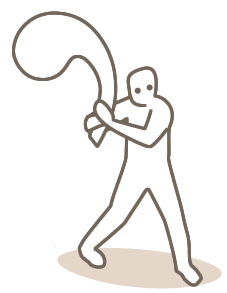The Apostrophe and Me
For years I have struggled with the dreaded apostrophe. I remember setting in my freshman composition class claiming to be a master of apostrophe usage. I felt I knew the rule. I, surely, had a firm grasp on it. But! In writing I found out I didn’t. I would make stupid mistakes like not signaling the possessive with an apostrophe. Worst of all, I would place apostrophes everywhere for no reason. So, after my professor pointed out that I continued to make these detail orientated mistakes. I have decide to isolate the problem.
So the best way to do this is have a check list available when proof reading.
Proof Reading Check List:
- Check all possessives for correct punctuation
- Check proper nouns for correct usage
- look at dates and contractions
- Check usage of It's and Its (should not be a problem but I have been wrong before)
3.2.7 Apostrophes:
"A principal function of apostrophes is to indicate possession. They are also used in contractions (can’t, wouldn’t), which are rarely acceptable in research papers, and the plurals of the letters of the alphabet (p’s and q’s, three A’s)"
a. To form the possessive of a singular noun, add an apostrophe and an s.
a poem’s meter
b. To form the possessive of a plural noun ending in s, add only an apostrophe.
firefighters’ trucks
c. To form the possessive of an irregular plural noun not ending in s, add an apostrophe and an s.
women’s studies
d. To form the possessive of nouns in a series, add a single apostrophe and an s if the ownership is shared.
Palmer and Colton’s book on European history
But if the ownership is separate, place an apostrophe and an s after each noun.
Palmer’s and Colton’s books on European history
e. To form the possessive of any singular proper noun, add an apostrophe and an s.
Venus’s beauty
Dickens’s reputation
f. To form the possessive of a plural proper noun, add only an apostrophe.
the Vanderbilts’ estate
the Dickenses’ economic woes
g. Do not use an apostrophe to form the plural of an abbreviation or a number.
PhDs
MAs
TVs
1990s
fours
SAT score in the 1400s
Grammar Girl’s The
Ultimate Writing Guide for Students
Possessives: Showing ownership—that something belongs
to someone? The basic rule is to add an apostrophe and s. Do so, and you
have created a possessive.
Aardvark’s Pencil
The apostrophe and s at the end of Aardvark
means that the pencil belongs to Aardvark. It does not mean the plural of
Aardvark, and it does not mean “Aardvark is pencil.”
(Fogarty 147).
Here is another great tip Compound Possession:
“If you’re writing about possession and have two
subjects, you have to decide whether the two people possess something together
or separately.”
Squiggly and Aardvark’s cats are black
The rule is if the two people share something, you
use one apostrophe and s.
The rule is if they each possess something
different, they each get an apostrophe and s.
Squiggly’s and Aardvark’s cats are black.
(Fogarty 148-149)
Grammar Girl's Podcast on apostrophes
Grammar Girl's Podcast on apostrophes



Comments
Post a Comment